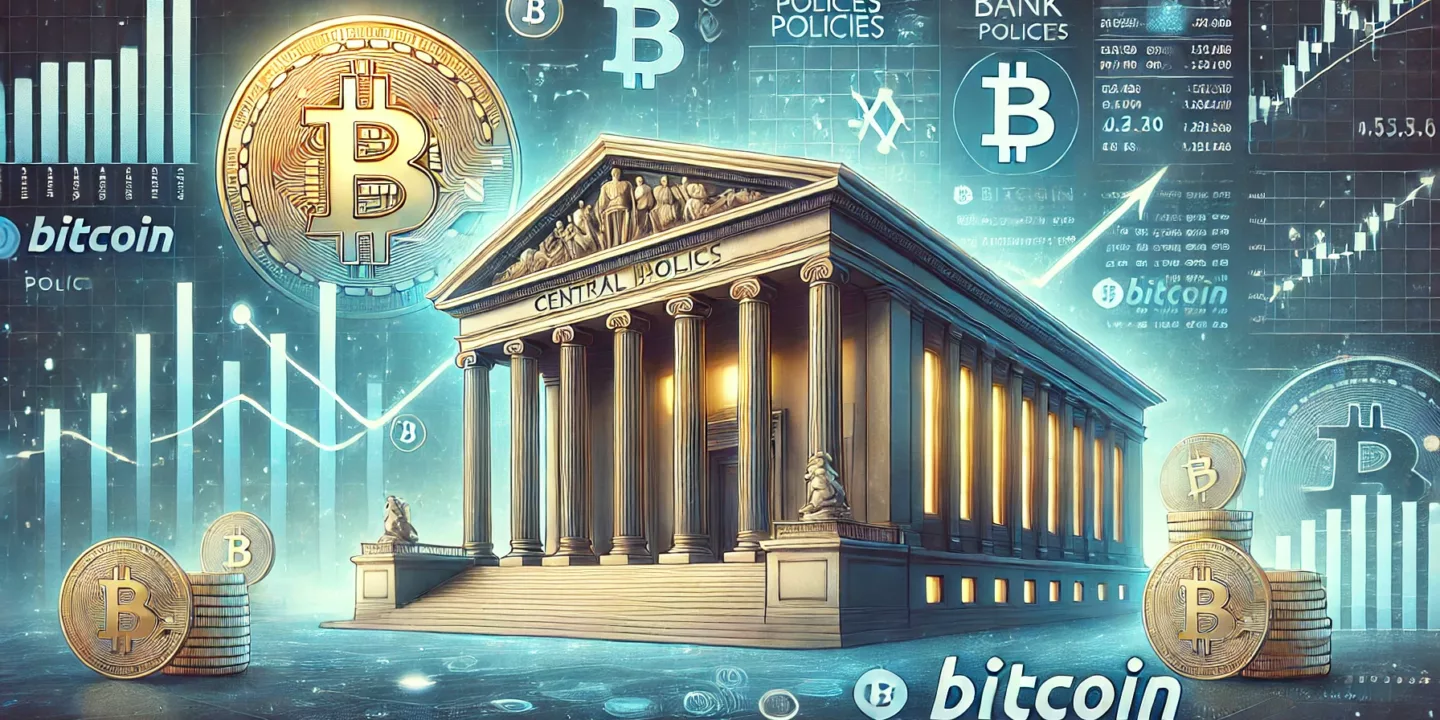
How Central Bank Policies Influence Bitcoin’s Price?
Bitcoin, the world’s first decentralized cryptocurrency, has often been regarded as a revolutionary asset class. Its unique properties, like decentralized control, limited supply, and global accessibility, make it a fascinating investment option for customers. Unlike the traditional financial markets, Bitcoin’s price is not immune to external forces, particularly central bank policies.
The central bank plays a crucial role in shaping the global economic conditions. The actions of the central bank can also play a crucial role in influencing Bitcoin’s valuation. In this article, we will see how the central bank’s policies, like interest rate adjustments, inflation management, and quantitative easing, impact Bitcoin’s price. We will also explore its role as a hedge against the monetary systems.
Key Takeaways
- Brief overview of the central bank policies.
- Crucial central bank policies. How they impact Bitcoin?
- How bitcoin acts as a hedge against the central bank policies.
Central Banks: A Quick Overview
The central banks are the primary authorities responsible for managing the nation’s monetary policies. Institutions like the European Central Bank, the Federal Reserve in the US and the Bank of Japan aim to stabilize the economies. They do so by controlling the inflation, economic growth and employment.
The banks achieve this by using various tools like interest rate adjustments, currency management and open market operations. The central bank policies ripple through the traditional markets, influencing everything from equity prices to foreign exchange rates. And now they have also begun to influence the Bitcoin rates.
Since Bitcoin is a decentralized asset, it stands completely outside the direct control of the central banks. However, the value of Bitcoin is indirectly tied to the Central Bank’s policies due to investor behaviour, macroeconomic trends, and perception of it as a hedge against fiat currency devaluation.
ALSO READ: INR Depreciation and Bitcoin: What is the Connection?
Key Central Bank Policies and Its Impact on Bitcoin
1.Inflation Management
Inflation refers to the gradual increase in the price of goods and services. It reduces the purchasing power of the fiat currencies over time. Central Banks tighten the monetary policies to fight against inflation. It reduces the money supply and raises the interest rates. These measures help stabilise the currency value and lessen runaway price increases.
Bitcoin’s appeal as a store of value increases during times of high inflation. Having a fixed supply of 21 million coins, bitcoin is inherently deflationary. Investors often look to Bitcoin as a digital gold. It acts as a hedge against inflationary pressures created by the central banks. For example, during the Covid 19 pandemic, inflation surged globally due to expansive monetary policies. It led to increased interest in Bitcoin as an alternative asset.
2.Interest Rate Changes
The central banks use interest rate adjustments to influence the borrowing and spending power in the economy. Borrowing becomes cheaper when the interest rates are low. It encourages investments and economic growth. On the other hand, high interest rates increase the cost of borrowing. It can slow down economic activity.
Bitcoin’s price often reacts inversely to the interest price movements. Low interest rates reduce the opportunity cost of holding non-yielding assets like Bitcoin and make it an attractive option for investors. On the other hand, rising interest rates can lead to a decline in Bitcoin demand because traditional assets like savings accounts and bonds offer higher returns. For instance, Federal Reserve’s aggressive rate hikes in 2022 contributed to a broader market sell-off. It has largely impacted Bitcoin’s valuation.
3.Quantitative Easing and Tightening
Quantitative easing involves the central banks injecting liquidity into the economy by purchasing government securities and other financial assets. This policy is designed to stimulate the economic activities by increasing money supply and lowering the borrowing costs. Quantitative tightening is the opposite of easing. It involves reducing the liquidity by selling assets or allowing them to mature.
Bitcoin often benefits from the QE policies because excess liquidity in the financial system tends to flow into the riskier assets. The 2020 bull run in Bitcoin was partially fuelled by global QE policies implemented against the COVID-19 pandemic. On the other hand, QT can exert downward pressure on Bitcoin’s price as the liquidity dries up. Here, the investors also become more prone to the risks.
4.Currency Devaluation
Currency devaluation occurs when a central bank intentionally or unintentionally lowers the value of its currency compared to others. This happens in economies with high inflation, political instability and trade imbalances. Devaluation reduces the purchasing power of individuals and can also eliminate the trust in fiat currencies.
Bitcoin, being decentralized and independent of any single economy, is often considered a safe asset during currency devaluation. For example, countries like Argentina and Turkey, which have experienced significant currency devaluation, have observed a surge in Bitcoin adoption as the citizens look to protect their wealth.
Bitcoin as a Hedge Against the Central Bank Policies
The decentralized nature and fixed supply make Bitcoin a compelling hedge against the unpredictable effects of central bank policies. Unlike fiat currencies, which can be printed in unlimited numbers, the scarcity of Bitcoin provides a level of protection against currency devaluation and inflation.
When the central banks introduce expansionary policies or during periods of economic instability, Bitcoin often serves as a store of value. The performance of Bitcoin during 2020-2021, marked by aggressive QE policies, highlights its potential as an alternative asset. However, the speculative nature and high volatility of Bitcoin means that it is not without risks.
Investment Strategies in a Central Bank Driven Market
To find out the influence of Central Bank on Bitcoin, investors can adopt certain strategies.
- Diversification
Combining bitcoin with other assets like gold, bonds and stocks can help in lessening portfolio risk.
- Dollar Cost Averaging
Investing a fixed sum of money in Bitcoin at regular intervals helps in reducing the impact of market volatility.
- Monitoring Central Bank Announcements
Stay informed about the policy changes like inflation reports and interest rate decisions. It helps in anticipating the impact on Bitcoin.
- Use of Stop Loss Orders
Protect against the sudden price movements by setting stop loss levels for the Bitcoin investments.
Conclusion
The Central Bank policies play a crucial role in shaping the price dynamics of Bitcoin. These policies greatly influence market sentiment and investor behaviour, whether through interest rate changes, inflation management or quantitative easing. The limited supply and decentralized nature of Bitcoin positions it as a unique hedge against the shortcomings of traditional monetary systems. However, the speculative nature and volatility mean that market awareness and a careful strategy are crucial for its success.
With evolving global economic conditions, the interplay between Central Bank policies and Bitcoin’s price will continue to grow in complexity. You can follow Mudrex to stay informed about the proactive strategies. This helps investors to navigate the dynamic landscape and capitalize on Bitcoin’s potential in the central bank-driven world.
FAQ
1.What factors influence Bitcoin’s price the most?
Bitcoin’s price is primarily affected by the market’s demand, its price, competing cryptocurrencies, availability and investor sentiment.
2.What advantages does Bitcoin have over centralized banking systems?
Bitcoin enables faster and cheaper international transactions. It eliminates currency conversion fees and intermediaries. Traditional banks have longer processing times and higher fees.
3.Who controls Bitcoin’s prices?
Unlike the fiat currencies, the value of Bitcoin is not defined by a single entity. Instead, its price is influenced by supply and demand.





